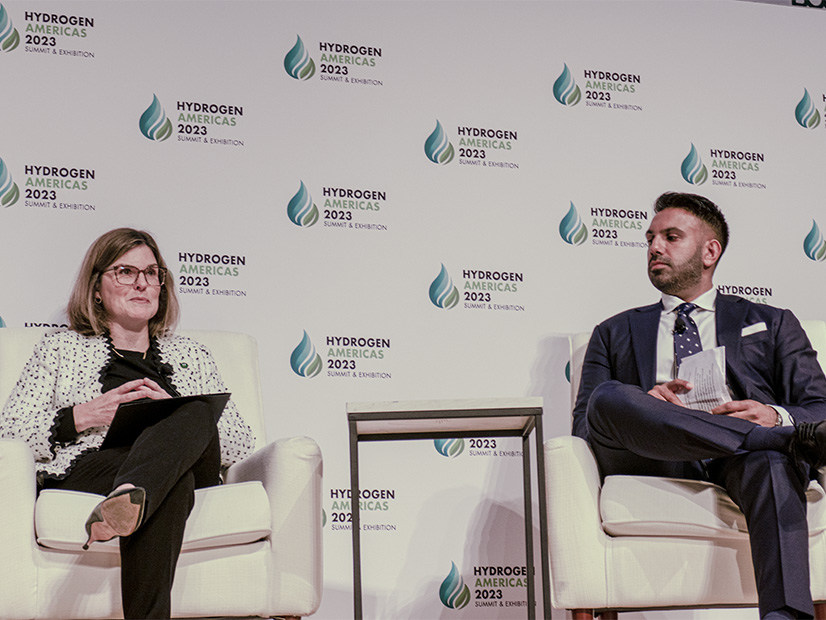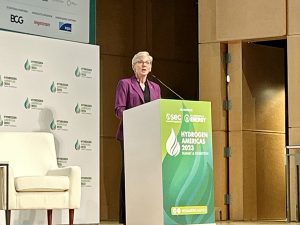
While a lot of progress has been made, getting to a fully decarbonized economy is going to require new technologies, U.S. Energy Secretary Jennifer Granholm said Tuesday at this year’s Hydrogen Americas Summit.
“It is certainly going to be helpful to decarbonize our hardest-to-abate sectors: obviously heavy industry [and] transportation,” Granholm said. “Hydrogen, as you all know, could lead to clean dispatchable baseload electricity; it can provide options for long-duration energy storage and shore up our energy security, especially during supply chain breakdowns.”
Granholm joked that unfortunately she was not at the conference, hosted by the Department of Energy and the Sustainable Energy Council, to make any major announcements, with the industry waiting for word from her department on the applications to build regional “hydrogen hubs” around the country. (See DOE Opens Solicitations for $7B in Hydrogen Hubs Funding.)
While hydrogen is already used in applications ranging from refining oil to rocket fuel, and legacy firms such as Air Products and Air Liquide were well represented at the conference, the hope is for hydrogen to become what Granholm called the “Swiss Army knife” of the clean energy revolution.
The hubs are meant to help start building the future domestic industry by linking together regional supply and demand, which ideally will help provide a foundation for the fuel to become commonplace in global energy supplies.
“We expect these hubs will marry supply and demand so that we can be producing where the offtake is,” Granholm said. “And as I say, we’re very close to announcing those hubs.”
If the Biden administration’s goals for domestic, clean hydrogen production by 2030 are met, the U.S. would produce enough of the fuel to meet the same amount of energy used by every bus and train in the country, Granholm said. The 2040 goal would double that production to 20 million metric tons, while the 2050 goal would have the U.S. produce enough clean hydrogen to meet the equivalent energy demand of every bus, train, ship and plane in the country, she added.
Other countries around the world are ramping up their production of hydrogen, and Granholm said the U.S. would be happy to work with them.
“We need to develop uniform codes, uniform standards, to maximize safety to minimize harmful leakage,” Granholm said. “We need to ensure that emissions analyses are done consistently across regions and that certification measures are rigorous and practical, as well as transparent.”
Countries also need to work together to help create new markets for the fuel and get new sources of demand comfortable with using the fuel, she added.
The government’s plan to help grow hydrogen into a clean energy industry involves focusing first on strategic, high-impact end uses such as “hard to decarbonize” industries, heavy-duty transportation and energy storage, DOE Hydrogen Program Coordinator Sunita Satyapal said.
“Second is laser focus on reducing the cost,” Satyapal said. “Again, it has to be competitive from a market-sustaining perspective. And then third is focused on regional networks. So that’s where the hubs come in: How do we potentially co-locate large-scale production and use?”
As the industry develops, hydrogen will need to be shipped. One idea to do that is over pipelines, but no regulatory regime to site, construct and oversee that infrastructure has been developed. FERC Commissioner Allison Clements told the conference Wednesday that she has asked Congress to come up with a plan to regulate those pipelines.
“You want to have some sort of one-stop shop or coordinated effort at the federal level that allows for the responsible, effective and efficient facilitation of interstate pipelines,” Clements said.
For now the focus is on intrastate pipelines, with just 1,600 miles transporting hydrogen compared to 300,000 miles of interstate natural gas pipelines overseen by FERC. But as the industry matures, it will want to connect different states, so some kind of regulatory regime will be needed, Clements said.
Hydrogen molecules (H2) flowing through pipelines will be much smaller than methane molecules (CH4) and thus have an easier time escaping, said Steven Hamburg, the Environmental Defense Fund’s chief scientist.
That is an issue even for green hydrogen, which is produced exclusively by zero-emitting generation, let alone blue hydrogen, produced with natural gas and carbon capture, with the industry having to consider upstream methane emissions, Hamburg said.
“We have to remember that hydrogen is a potent, indirect greenhouse gas,” Hamburg said. “It roughly lasts in the atmosphere … about the same length as methane, and its potency is about half of methane. And unfortunately, we don’t know anything about how much is being emitted currently.”
NASA uses hydrogen for its rockets; Hamburg said that when the fuel is transferred to them, it can lose up to 13% of its volume being blown away in the atmosphere, so ensuring such releases are minimized when it becomes much more commonly used is vital. Measurement technology is only being developed now, and it is needed not just to track the small leaks along its supply chain but also to help avoid any accidents with the volatile gas, Hamburg said.
Hamburg has been deeply involved in EDF’s efforts to track natural gas leakage. When that work began, many doubted that it was actually happening, but with actual measurements, leakage has proved common.
“It’s really important to note when I first started talking with companies about this issue 13 years ago, everyone told me, ‘We wouldn’t waste product; we’re not emitting much methane,’” Hamburg said. “That simply isn’t true. I hear a lot of that from the hydrogen industry. I can’t say it’s not true because we don’t have the measurements. But it is a bit of caution.”
Supply-side vs. Demand-side Policies
The U.S. and EU have come at the problem of making hydrogen a major energy source, and addressing climate change, in the opposite directions, said Michel Heijdra, the Netherlands’ vice minister of climate and energy.
“The U.S. for certain reasons, of course, focuses on subsidies in the value chain, whereas Europe focuses on carbon pricing and setting certain obligations for that offtake,” he added.
Both are spending money to help stand up hydrogen and other decarbonization options, and ultimately Europe will need to focus on cutting the cost of the fuel to get wide adoption, while the supply subsidies alone likely will not be enough to have major industries adopt new fuels and equipment, he added.
The international community also eventually will have to come together to make some standards around hydrogen production so that customers can be sure they are getting what they pay for, said David Hart, partner at consulting firm ERM.
“We’ve learned, I think, from previous areas where we have not done this as well, in biofuels and other jurisdictions where it’s quite easy to game markets by taking a biofuel that’s produced somewhere and moving it,” Hart said. International agreements around hydrogen need to be structured carefully so that such gaming is not easy to do, he added.
High Costs Must be Cut
BP already uses hydrogen at refineries it runs around the world, but it uses traditional “gray” hydrogen, produced by natural gas without any carbon capture, said Vice President Tomeka McLeod.
“There still is quite a big gap between … the cost of gray hydrogen under levelized costs versus what you would see for clean hydrogen … even with the Inflation Reduction Act,” McLeod said.
The price gap narrows for blue hydrogen, but it is still big enough that customers might not see the benefit of switching to green hydrogen.
“A number of the industries that use hydrogen have very thin margins,” McLeod said. “If their customers are not willing to pay a premium, it’s going to be pretty tough to incent them to pay a premium.”
Fueling the electrolysis machines that can make green hydrogen is going to be difficult and expensive, leaving that business to a few firms that can actually deliver on the idea, said Intersect Power CEO Sheldon Kimber. Green hydrogen might need to be directly linked to renewable generation, especially given the difficulties of expanding the transmission grid.
“When you look at the scale of these kind of monster behind-the-meter renewables facilities, which is what we think is going to transpire here … 80% of that is the renewables,” Kimber said. “And so, you make a list of people who may have built a 500-MW-plus renewable facility in the U.S., [and] it’s very small list. You make a list of people who have delivered that in the last few years through the supply chain crisis, financing issues and all of that — that’s a much smaller list.”
Hydrogen in Transportation
While much of the focus on hydrogen recently has been on hard-to-decarbonize industries, many are pursuing its use in transportation — even in the light-duty vehicle segment where electric cars have come to dominate the clean space.
BMW has 25 electric vehicles available to consumers around the globe, but it is also considering adding light-duty hydrogen cars to its portfolio, said company representative Thiemo Schalk.
“There are studies coming from the European Union, and from Germany as well, suggesting that once you are coming close to a huge part of the car market being electrified, the costs for the infrastructure for the charging outlets [are] going to be increasing really, really sharply,” Schalk said.
The costs go up as the grid needs to be bolstered and clean resources are added to the mix to serve the new demand from cars, with estimates that Europe would have to spend $1.5 trillion to go 100% electric, Schalk said. But that comes down significantly if some percentage of the light-duty market is served by hydrogen or another alternative, which some customers will wind up preferring over EVs as well.
Going electric in the heavy-duty sector is more difficult because the current battery designs are too heavy, especially for airplanes, said Airbus Americas Vice President of Research and Technology Amanda Simpson. Airbus sees hydrogen as the main option for decarbonizing air travel and hopes to have a plane using it in service by 2035.
But the company is not yet sure whether that plane would use a hydrogen fuel cell or directly combust the gas in its engines, Simpson added. Getting liquid hydrogen on aircraft and doing it safely is also a focus of those developments, but hydrogen has major advantages over the alternatives.
Biofuels still produce pollutants when combusted, and batteries are just too heavy to have any impact outside of short-haul, local flights, she added.
Hydrogen Generation is Possible, but Expensive
The IRA has supercharged interest in hydrogen, with projects before it being much smaller, said Siemens Energy North America President Richard Voorberg. Before the law, Siemens was working on electrolyzers of about 18 MW, but it has scaled up and has plans for projects above 1 GW.
Those major projects are starting to roll out at once and eventually will lead to a backlog as the industry can only do so much at once, Voorberg said.
“The challenge is economics,” Voorberg. “And we don’t see the economics start making sense until probably 2035 at the earliest. So, we think things like decarbonizing industry, steel-manufacturing, chemicals, ammonia, fertilizer, transportation — all those go first [and] pave the way. And then eventually, the high price of hydrogen gets to the right position and then you can burn it in gas turbines for energy production.”


